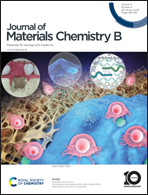Periodontal bone regeneration with a degradable thermoplastic HA/PLCL bone graft†
Abstract
Strategic bone grafts are required to regenerate periodontal bone defects owing to limited self-healing. Current bioceramic particle or deproteinized bovine bone (DBB) products are not able to ideally meet clinical requirements, such as insufficient operability and slow degradation rates. Herein, a strong-interacted bone graft was designed and synthesized by modifying hydroxyapatite (HA) with a lactide–caprolactone copolymer (PLCL) to improve component homogeneity and mechanical properties. The physical-chemical analysis indicated that HA particles were homogenously distributed in HA/PLCL bone grafts, possessed outstanding thermoplasticity, and facilitated clinic operability and initial mechanical support. The in vitro study suggested that HA/PLCL bone graft degraded in a spatiotemporal model. Micropores were formed on the non-porous surface at the beginning, and interconnected porous structures were gradually generated. Furthermore, HA/PLCL bone grafts exhibited excellent biocompatibility and osteogenic ability as revealed in vitro cell culture and in vivo animal experiments. When applied to rat periodontal bone defects, the HA/PLCL bone graft showed a non-inferior bone regeneration compared to the commercial DBB. This study proposes a potential bone graft for periodontal bone repair with thermoplastic, spatiotemporal degraded, and osteogenic characteristics.



 Please wait while we load your content...
Please wait while we load your content...